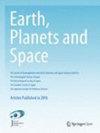Characteristics and longitudinal extent of VLF quasi-periodic emissions using multi-point ground-based observations
IF 2.5
3区 地球科学
引用次数: 0
Abstract
Abstract Quasi-periodic (QP) emissions are a type of magnetospheric ELF/VLF waves characterized by a periodic intensity modulation ranging from tens of seconds to several minutes. Here, we present 63 QP events observed between January 2017 and December 2018. Initially detected at the VLF receiver in Kannuslehto, Finland (KAN, MLAT = 67.7°N, L = 5.5), we proceeded to check whether these events were simultaneously observed at other subauroral receivers. To do so we used the following PWING stations: Athabasca (ATH, MLAT = 61.2°N, L = 4.3, Canada), Gakona (GAK, MLAT = 63.6°N, L = 4.9, Alaska), Husafell (HUS, MLAT = 64.9°N, L = 5.6, Iceland), Istok (IST, MLAT = 60.6°N, L = 6.0, Russia), Kapuskasing (KAP, MLAT = 58.7°N, L = 3.8, Canada), Maimaga (MAM, MLAT = 58.0°N, L = 3.6, Russia), and Nain (NAI, MLAT = 65.8°N, L = 5.0, Canada). We found that: (1) QP emissions detected at KAN had a relatively longer observation time (1–10 h) than other stations, (2) 11.3% of the emissions at KAN were observed showing one-to-one correspondence at IST, and (3) no station other than IST simultaneously observed the same QP emission as KAN. Since KAN and IST are longitudinally separated by 60.6°, we estimate that the maximum meridional spread of conjugated QP emissions should be close to 60° or 4 MLT. Comparison with geomagnetic data shows half of the events are categorized as type II, while the rest are mixed (type I and II). This study is the first to clarify the longitudinal spread of QP waves observed on the ground by analyzing simultaneous observations over 2 years using multiple ground stations. Graphical Abstract基于多点地面观测的甚低频准周期发射特征和纵向范围
准周期(QP)发射是一种以几十秒到几分钟的周期性强度调制为特征的磁层ELF/VLF波。在这里,我们展示了2017年1月至2018年12月期间观测到的63个QP事件。最初在芬兰Kannuslehto的VLF接收器上检测到(KAN, MLAT = 67.7°N, L = 5.5),我们继续检查这些事件是否同时在其他亚极光接收器上观察到。为此,我们使用了以下PWING站点:Athabasca (ATH, MLAT = 61.2°N, L = 4.3,加拿大)、Gakona (GAK, MLAT = 63.6°N, L = 4.9,阿拉斯加)、Husafell (HUS, MLAT = 64.9°N, L = 5.6,冰岛)、Istok (IST, MLAT = 60.6°N, L = 6.0,俄罗斯)、Kapuskasing (KAP, MLAT = 58.7°N, L = 3.8,加拿大)、Maimaga (MAM, MLAT = 58.0°N, L = 3.6,俄罗斯)和Nain (NAI, MLAT = 65.8°N, L = 5.0,加拿大)。研究发现:(1)KAN观测QP的时间较其他站点长(1 ~ 10 h), (2) KAN观测到的QP排放量与IST观测到的QP排放量有11.3%的对应关系,(3)除了IST以外没有其他站点与KAN同时观测到相同的QP排放量。由于KAN和IST在纵向上相距60.6°,我们估计共轭QP辐射的最大经向传播应该接近60°或4 MLT。与地磁数据的比较表明,一半的事件被归类为II型,而其余的事件则是混合(I型和II型)。本研究首次通过分析多个地面站2年来同时观测的数据,阐明了地面观测到的QP波的纵向传播。图形抽象
本文章由计算机程序翻译,如有差异,请以英文原文为准。
求助全文
约1分钟内获得全文
求助全文
来源期刊

Earth, Planets and Space
地学天文-地球科学综合
CiteScore
5.80
自引率
16.70%
发文量
167
期刊介绍:
Earth, Planets and Space (EPS) covers scientific articles in Earth and Planetary Sciences, particularly geomagnetism, aeronomy, space science, seismology, volcanology, geodesy, and planetary science. EPS also welcomes articles in new and interdisciplinary subjects, including instrumentations. Only new and original contents will be accepted for publication.
 求助内容:
求助内容: 应助结果提醒方式:
应助结果提醒方式:


